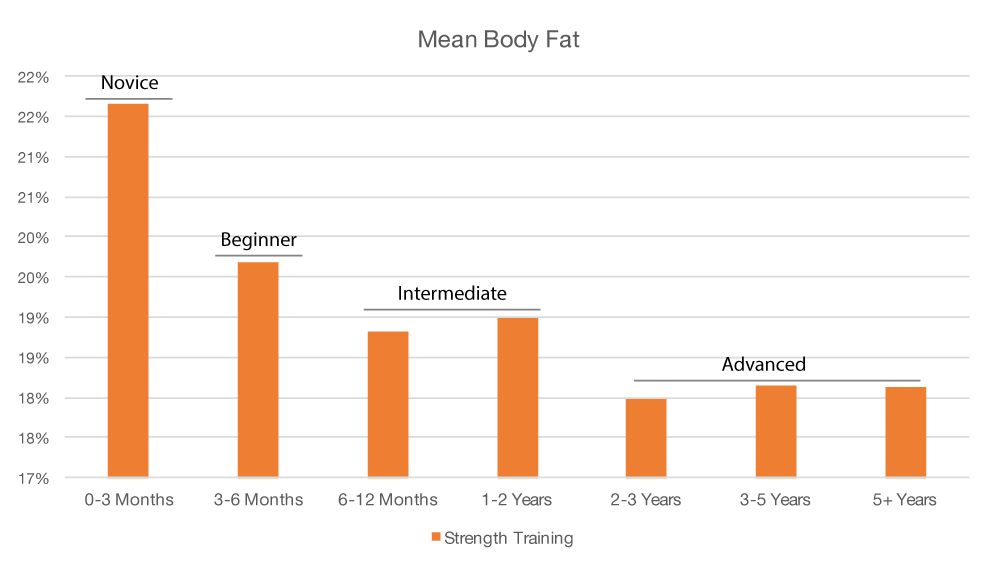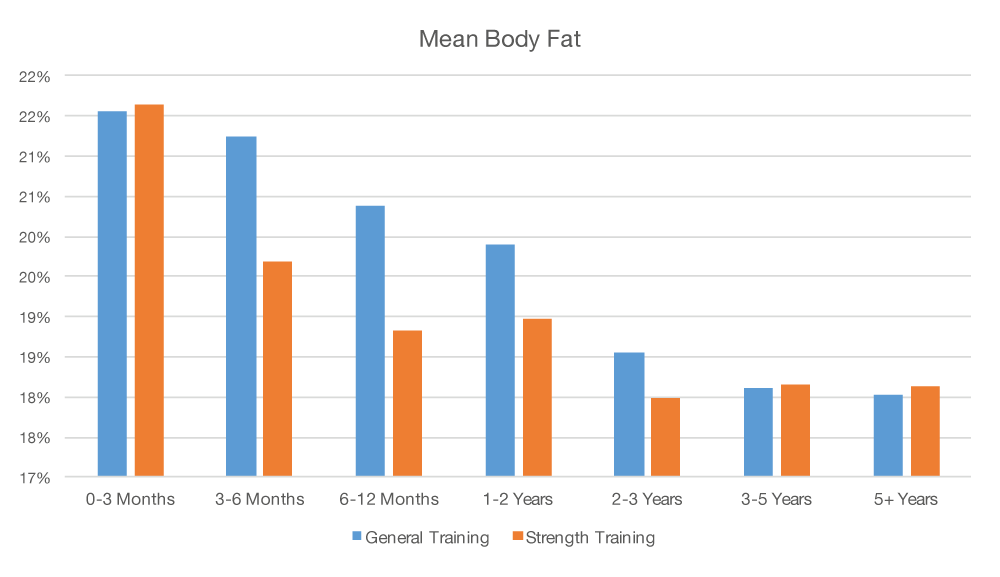Faster Fat Loss with Strength Training?
Most people would agree there is some association between working out and a reduction in body fat. Many people even argue that certain types of exercise show a stronger association than others. Some even go so far as to say “Do these 5 exercises to torch the flab”. Really? Maybe. At least it appears that way.
All else being equal, a greater amount of physical activity does lead to a reduction in body fat. How that plays out over time is not as clear. Do you keep losing fat year after year? And if so, do you lose fat at the same rate or does the rate slow down over time? You’d probably guess that fat loss slows down and levels out at some point. That leads to the next question: how long does it take to max out on fat loss? Three months? Hopefully not.
Let’s look at the data.
As part of the initial setup process, users are asked to enter a series of basic inputs, which are used to configure the app, such as height, weight, age, training experience, goals, and so on. That, combined with workout performance data and a bit of machine learning sauce on top, allows for the determination of body fat (try it out). Put it all together, then slice and dice it up a bit, and we get the following relationship between mean body fat and training duration. The sample size is ~10,000.
Figure 1. Strength training experience vs mean body fat
Okay, that’s about what we expected to see. But you’re wondering about the additional labels (novice, beginner, intermediate and advanced), right? There was no significant difference in mean body fat between 6-12 months and 1-2 years, nor was there between 2-3 years, 3-5 years, and 5+ years. However, the difference was significant between the labeled groups. Those groups needed names and here we are.
It appears then that fat loss associated with strength training is greatest in the first 6 months and maxes out after 2-3 years of training — on average.
What about fat loss associated with general training, defined here as anything other than strength training?
Figure 2. General and strength training experience vs mean body fat
The data shows a similar trend of decreasing mean body fat with increasing training duration, with one notable exception — the initial fat loss from strength training is greater. However, both forms of training reach agreement in terms of mean body fat at ~3+ years. All roads lead to Rome, some just get you there faster.
What about interactions between the two? For example, two people with little to no strength training experience may differ in that one has been physically active for years and the other has not. To examine this relationship, each form of training (strength and general) was divided at the 6-month mark — the beginner and intermediate boundary shown above.
Figure 3. Mean body fat cross-relationships between general and strength training experience
Starting at zero, with less than 6 months of any type of training, picking up strength training and sticking with it for more than 6 months is associated with a significant reduction in mean body fat while pursuing other forms of exercise is not associated with any significant change. Also, notice that doing both is associated with the lowest mean body fat. If you’re not doing one or the other you might want to pick one up.
Is strength training really better for fat loss?
This is a field study and not a controlled laboratory experiment. What we are seeing here is how things play out in the real world, not necessarily a mechanistic insight into body fat loss. The body probably does not differentiate between 500 calories burned from strength training and 500 calories burned from playing basketball.
The key here is likely that strength training usually comes as part of a diet and exercise ‘lifestyle package’, more so than playing basketball. Start lifting to get stronger and pretty soon you’re drinking protein shakes. The next thing you know you’re counting calories.
The takeaway here is that if you want to lose fat, coming at it from an angle, instead of head on, is a good way to approach it. Start strength training. Watch your strength increase from day to day. Get hooked on seeing progress. Once you’ve bought into that, take it a step further and start working on counting those macros.
Strength is a gateway drug.





